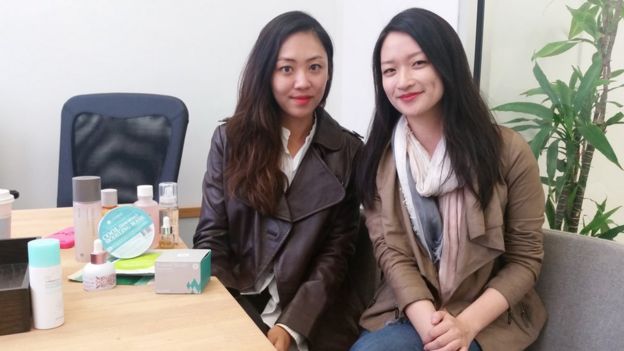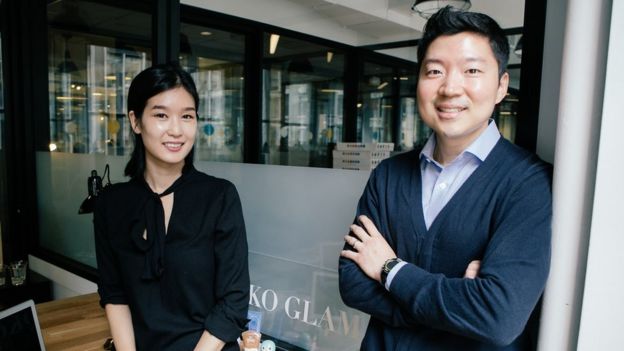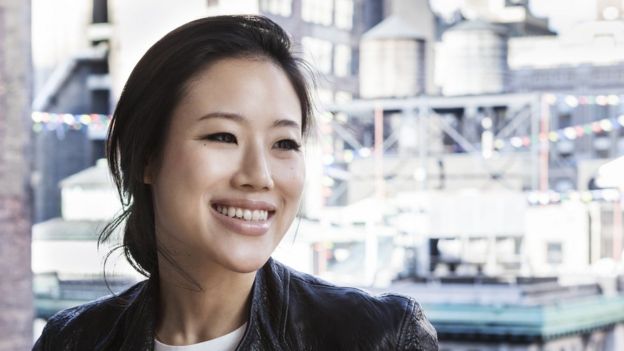- 28 January 2016
- Business
-
(비지니스) 한국 스킨케어 산업의 성공 요인아름다운 인생/비지니스 2016. 1. 30. 16:09
출처: http://www.bbc.com/news/business-35408764
The key ingredients of South Korea's skincare success 한국 스킨케어 산업의 성공 요인
 Getty Images
Getty ImagesKorean women spend more of their money on cosmetics than those in any other country If you have never used a Korean face cream made from snail slime, then you may be missing out.
Likewise you may be being left behind if you don't spend an hour or two each week wearing a Korean face mask made from seaweed.
These are two products at the forefront of the latest big trend to hit the global skin care and cosmetics industry - the boom in such items developed and made in South Korea.
(성공요인 1) The Asian country has long been obsessed with skincare - South Korean women spend twice as much of their income on beauty products and make-up than their American counterparts. Meanwhile, South Korean men spend more on skincare than those in any other country. (성공요인 1) 한국은 다른 나라에 비해 남녀 둘 다 스킨케어에 더 많이 집착하고 있다. 여성들은 미국 여성들보다 자기 수입의 두 배를 미용 제품에 소비하고 있다. 남성들도 다른 나라 남성들보다 많은 돈을 스킨케어에 소비하고 있다.
Such a dedication to looking and feeling good means that South Korea is at the forefront of research into new skincare products, and its exports of such items are soaring.

Face cream made from snail extract is a popular Korean cosmetics product Last year, South Korea exported more than $2.64bn (£1.85bn) of cosmetics goods, a new high, according to the Korea Customs Service. This compares with $1bn in 2012, and $1.91bn in 2014. 한국은 작년(2015년)에 화장품 관련제품을 26조4천억 달러를 수출했다. 이는 2012년 10억 달러, 2014년 19억1천만 달러와 비교하면 크게 증가한 수치다.
One of the biggest export markets for Korean skincare products, which have been collectively dubbed "K-beauty", is the US, where the big rise in sales has been led by small firms, more often set up by young Americans of Korean ancestry.
(성공 요인 2) And the ingredients aren't ones traditionally found in American or European products. Snail extract, for example, is supposed to stimulate the formation of collagen and elastin, is used in moisturisers and spot treatments. (성공 요인 2) 한국산 화장품들의 원료들은 전통적으로 미국제품이나 유럽제품들에서 쓰였던 것들이 아니라 새로운 것들이다. 예컨대, 콜라겐이나 엘라스틴을 만드는 것으로 알려진 달팽이 추출물이 습윤제나 반점처리제로 쓰이고 있다.
(성공 요인 3) Dual knowledge (성공요인3) 두 문화에 대한 지식의 활용
In a beauty salon in New York's Koreatown district, business partners Christine Chang, 34, and Sarah Lee, 35, are holding forth on the newest trends in skincare products from South Korea.
 Glow Recipe
Glow RecipeSarah Lee (left) and Christine Chang used to work for L'Oreal Ms Lee holds up a poster of a frilly, white, translucent mushroom, explaining that the fungus is a new "ultra-hydrating" ingredient being used in skincare.
She has the full attention of her audience, a select group of beauty editors diligently taking notes.
Both Korean Americans, Ms Lee and Ms Chang first met 10 years ago, whilst working for global skincare giant L'Oreal in South Korea.
Back in 2014 they decided to use their dual knowledge of Korean skincare products and the US to start their own company called Glow Recipe.
Their business imports such items from South Korea, and its website sells 150 products. Their bestseller is a face mask made from kelp covered in a hydrating serum, which retails for $14.
Ms Less and Ms Chang says the business has been growing at an average 70% ever quarter since they launched.
(성공 요인 4) 'Cult following' (성공 요인 4) 열광적인 팬
The popularity of Korean beauty products in the US can be traced back to 2011 when, the then unknown product, "BB cream" first launched in the country. 한국 화장품에 대한 인기는 소위 "비비크림"이 미국에 상륙했던 2011년으로 거슬러 올라간다.
BB cream is a hybrid moisturiser and foundation that Korean women had been using for years. In 2014 the US market for BB cream alone was worth $164m. 비비 크림은 한국 여성들이 수년간 사용해온 습윤과 기초화장의 혼합제품이다. 2014년 미국 시장에서 비비크림 단일제품의 가치는 1억6천4백만 달러였다.
 Lauren Kallen
Lauren KallenCharlotte Cho blogs about Korean skincare products "South Korea's beauty industry has seen phenomenal growth," says Sarah Jindal, analyst for market research firm Mintel.
Still, there are some major differences between the Korean and the western approach to beauty. For example, while in the west it is typical for women to follow a three-step facial regime of cleanse-tone-moisturise, in South Korea there are 10 different steps, including the use of "essence" and "ampoule" creams, and a "sheet mask".
Bridging this beauty gap is where people like Korean American Charlotte Cho come in. Ms Cho runs the online beauty blog and shop Soko Glam with her husband, and also recently launched a book about Korean beauty secrets.
A native of California who moved to New York, Ms Cho, 30, says: "We helped drive this growth in 2012 [of the sale of Korean beauty products], when we started the company.
"At the time, I felt like there was a huge gap between US and Korea. There was a cult following, but no proper bridge between the two."
The blog and the book help explain and spread the Korean "beauty philosophy", and Ms Cho is a proponent of the 10-step routine. She says SoKo Glam is growing "exponentially" in its third year.
(성공 요인 5) 'Cherry pick' (성공 요인 5) 최고를 선별할 줄 아는 안목
Megan McIntyre, beauty director at lifestyle website refinery29.com, says that most American women who try the 10 steps can't keep it up.
"After a while, many women who tried to keep up realised that it was pretty damn expensive to use ten plus products a day, and there wasn't necessarily a huge, noticeable difference in their skin," she says.
 Getty Images
Getty ImagesSnails are supposed to be good for your skin "So instead they cherry picked the products that were best for their skin. An essence here, an ampoule there, an under-eye mask for emergencies.
"It became less about emulating the entire routine and more about finding something new to boost an existing routine."
But the dilemma for Western consumers remains - where to begin with this plethora of products?
Alicia Yoon, who runs New York-based Peach and Lily, an online store selling imported Korean beauty products, says it is important that firms like hers don't sell too many items.
 Hye-Ryoung Min
Hye-Ryoung MinAlicia Yoon limits the range of products that she sells "Our curation process is so rigorous that only 5% of the products we look at really make our cut," she explains.
From thousands of South Korean brands, she picked out about 50, and then visited their companies to look closely at their research and development process.
Ms Yoon, 33, who quit her job in private equity to start her company in 2012 says she hasn't looked back since.
'아름다운 인생 > 비지니스' 카테고리의 다른 글
(비지니스/영국) 영국도 근로자들은 삶이 날로 고달파지네 (0) 2016.02.03 (비지니스) 베트남이 제2의 실리콘밸리가 될 수 있는가? (0) 2016.02.03 (비지니스) 다국적 기업의 법인세 회피 등 조세회피 문제 다룬 협약에 OECD 31개국이 서명 (0) 2016.01.29 (비지니스) 수수께끼 같은 중국의 다수 경제인 실종 (0) 2015.12.14 (비지니스) 실종되었던 포선(复星복성) 창업자 구어 구앙창(郭广昌/곽광창) 대중 앞에 다시 나타나다 (0) 2015.12.14